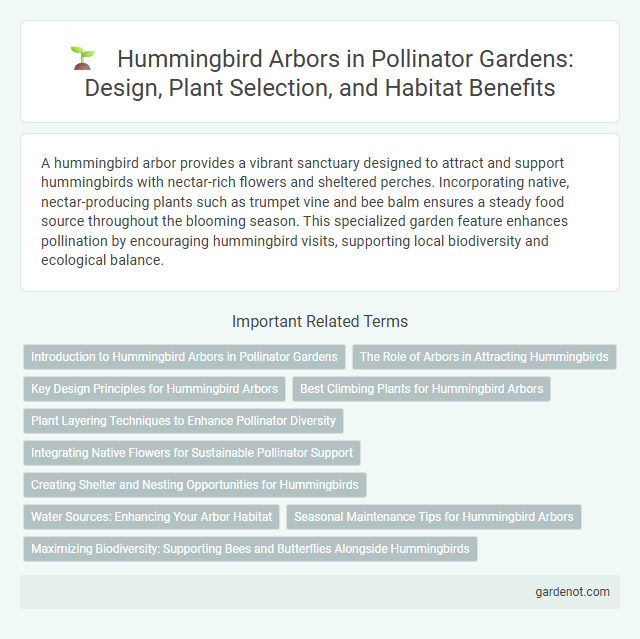A hummingbird arbor provides a vibrant sanctuary designed to attract and support hummingbirds with nectar-rich flowers and sheltered perches. Incorporating native, nectar-producing plants such as trumpet vine and bee balm ensures a steady food source throughout the blooming season. This specialized garden feature enhances pollination by encouraging hummingbird visits, supporting local biodiversity and ecological balance.
Introduction to Hummingbird Arbors in Pollinator Gardens
A hummingbird arbor serves as a vital structure in pollinator gardens by providing nesting sites and perches that attract hummingbirds essential for plant pollination. These arbors often feature nectar-rich flowers and strategically designed shelters that support hummingbird feeding and breeding behaviors. Integrating a hummingbird arbor enhances biodiversity and promotes the health of local ecosystems by facilitating natural pollination processes.
The Role of Arbors in Attracting Hummingbirds
Arbors provide essential perching and nesting sites that attract hummingbirds by mimicking natural habitats. Their vertical structure supports the display of nectar-rich flowers, increasing accessibility for hummingbirds to feed. Strategically placed arbors enhance pollinator activity by creating sheltered, visible spots vital for hummingbird territorial behavior and feeding efficiency.
Key Design Principles for Hummingbird Arbors
Hummingbird arbors should incorporate vibrant, nectar-rich flowers such as tubular red, orange, and pink blooms to attract these fast-moving pollinators. Structural elements like lightweight trellises or archways provide perching spots, while ensuring open spaces facilitate easy access for hummingbirds to hover and feed. Incorporating native plants and positioning the arbor in a sunny, sheltered location enhances visibility and safety, maximizing hummingbird visitation in the pollinator garden.
Best Climbing Plants for Hummingbird Arbors
Vining plants like trumpet vine (Campsis radicans), coral honeysuckle (Lonicera sempervirens), and passionflower (Passiflora incarnata) are ideal for hummingbird arbors due to their tubular flowers that attract hummingbirds. These climbers provide vibrant colors and ample nectar, essential for sustaining hummingbird activity throughout the growing season. Selecting native species ensures better adaptability and supports local pollinator populations effectively.
Plant Layering Techniques to Enhance Pollinator Diversity
Hummingbird arbors benefit from plant layering techniques that strategically combine nectar-rich flowers, shrubs, and climbing vines to create diverse vertical habitats. This method maximizes floral availability across different heights, attracting a wider range of pollinators, including hummingbirds, bees, and butterflies. Integrating native plants such as trumpet vine, coral honeysuckle, and bee balm enhances both visual appeal and ecological function, supporting pollinator health and garden biodiversity.
Integrating Native Flowers for Sustainable Pollinator Support
A hummingbird arbor integrated with native flowers creates an essential habitat for local pollinators by providing nectar-rich blooms throughout the growing season. Selecting native species such as red columbine, bee balm, and trumpet vine ensures ecological compatibility and supports hummingbird feeding and nesting behaviors. This sustainable planting strategy enhances biodiversity, conserves water, and reduces the need for chemical interventions in pollinator gardens.
Creating Shelter and Nesting Opportunities for Hummingbirds
Hummingbird arbors provide essential shelter by offering dense foliage and shaded areas that protect hummingbirds from predators and harsh weather. Incorporating native flowering plants with sturdy branches encourages nesting and supports the lifecycle of hummingbirds. Strategic placement of the arbor near nectar-rich flowers enhances habitat quality and improves breeding success rates.
Water Sources: Enhancing Your Arbor Habitat
Water sources play a crucial role in enhancing a hummingbird arbor habitat by providing essential hydration and bathing spots that attract and sustain these pollinators. Incorporating shallow dishes, mister systems, or small fountains ensures a continuous water supply, preventing stagnation and promoting health. Strategically placing water features near diverse native flowering plants maximizes the arbor's appeal and supports hummingbird activity year-round.
Seasonal Maintenance Tips for Hummingbird Arbors
Regularly prune dead or overgrown branches on hummingbird arbors during late winter to promote healthy growth and improve flower visibility. Clean feeders weekly with a mixture of water and white vinegar to prevent mold and bacteria that can harm hummingbirds. Inspect the structure for damage or pest infestations each season to ensure a safe and inviting habitat for pollinators throughout the year.
Maximizing Biodiversity: Supporting Bees and Butterflies Alongside Hummingbirds
A hummingbird arbor designed to maximize biodiversity incorporates native flowering plants that attract not only hummingbirds but also bees and butterflies, creating a vibrant ecosystem. Including a variety of nectar-rich blooms with staggered blooming seasons ensures continuous food sources for pollinators throughout the year. Strategic placement of host plants for butterfly larvae and installing bee-friendly nesting habitats further enhances pollinator diversity and supports ecosystem resilience.
Hummingbird arbor Infographic

 gardenot.com
gardenot.com